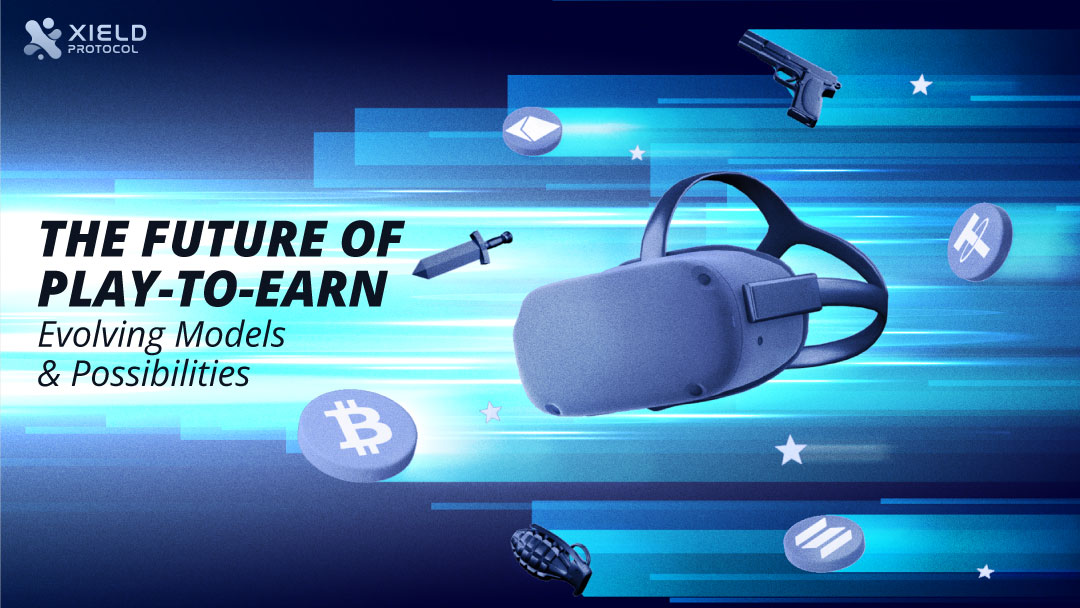Hello gamers! How do you feel about embarking on the next gaming adventure with the support of technology? For those who prefer play-to-earn (P2E) games, get ready for a whole new level of fun. With the blockchain gaming paradigm, which allows players to earn real funds through their in-game activities, already gaining traction, it is no surprise that a new age in gaming will soon begin. But were you aware that this is simply the beginning of a new era?
As the gaming business expands, it will introduce you to a slew of groundbreaking technology and exciting new games that will completely blow your mind. Consider innovative economic models that not only improve gaming but also allow players to earn additional rewards, spectacular experiences that add lifelike effects to gameplay, and the natural integration of top-tier technology such as artificial intelligence (AI) and the metaverse.
This article will help you find the future of blockchain gaming beyond P2E. We’ll showcase important trends, breakthrough inventions, and statistical insights that are poised to revolutionize the defi gaming industry.
Come, let’s dive into the future of gaming together!
How can gaming evolve from being a time sink to a lucrative income stream?
Think back to your favorite game. How many hours have you spent methodically creating your character, gathering rare equipment, and finding mod codes for your game, or plotting your next move? With traditional gaming, the only benefit is a sense of accomplishment, while profits are solely with the game developers. This is where decentralization and blockchain act as a utility mechanism, i.e., a secure and transparent digital ledger system, Play-to-earn upsets traditional business.
Non-fungible tokens (NFTs) provide players with actual ownership of in-game assets via blockchain. These unique digital tokens reflect people, weapons, virtual territory, and even in-game funds. These can be purchased freely or needed to level up the game, sold, or exchanged within the game’s marketplace or on exchange, bringing up a whole new world of possibilities.
But what’s the biggest plot twist? These in-game assets might have real-world worth. Players can earn cryptocurrency by completing missions, engaging in fights, or breeding and selling NFT animals, which can then be turned into cash.
Problems with Today’s Play-to-earn Approach
While P2E has fascinating potential, the current era of games faces several serious challenges. By addressing these problems, we can know why new Web3 game platforms are evolving. For example:
Sustainable Tokenomics
Tokenomics is the creation and management of a game’s coin or token, emphasizing supply, demand, and profitability. A gaming token should have a limited supply, making it unique and precious, and should have benefits such as asset purchases or participation in governance.
However, poor tokenomics can often lead to the price volatility of coins. For example, the first play-to-earn crypto game, Crypto Kitties, was affected by the overbreeding of kitties, resulting in an overstock of NFTs. This impacts the coin’s worth and ecosystem.
High Entry Barriers
Furthermore, the high entrance barriers make it difficult to invest in a play-to-earn game to be able to play in the first place. Many P2E games require users to buy expensive unique tokens, and NFTs, which make them pricey so that they can play properly and efficiently.
In the case of a game in which the profit percentage depends on the player’s initial investment, NFT monsters represent such assets that too are only possible to play on a higher level. This cost might be a stopper that is quite heavy because of digital scarcity, and such a situation is likely to impede the wide adoption of the game.
Limited Gameplay Focus
Some games offer in-game money for free play-to-earn rewards rather than delighting the person who was playing. This can be expressed as the prizes taking priority over the idea of simply playing the game, and in such cases, the game might start feeling like an unpleasant obligation. The technique will lead to players leaving the game, where they rapidly become uninterested and quit after reaching their initial earning targets. To have a sustainable effect, web3 games that allow users to play and earn must complement and improve the lifetime of the gamers reasonably and humorously.
Emerging Trends in Blockchain Gaming
Interoperability and Cross-Game Economics
One of the most exciting advancements in blockchain gaming is interoperability, which enables developers to develop play-to-earn game assets to be used across numerous games and platforms. This method helps players transform their in-game assets, resulting in a more integrated gaming ecosystem. For example, Enjin’s “Efinity” network attempts to improve cross-chain interoperability and allow gamers to use NFTs across multiple gaming realms.
Metaverse Integration
The merging of blockchain gaming with the metaverse, a virtual reality arena in which users may interact with a computer-generated environment as well as other users, marks a key frontier. Blockchain enables genuine ownership of digital assets in the metaverse. Bloomberg estimates that the metaverse business might be worth $800 billion by 2024, with gaming being a major component.
Decentralized autonomous organizations (DAOs)
DAOs are becoming more popular in blockchain gaming because they allow players to be part of the administration in the gaming ecosystem. Token-based voting systems let these organizations make choices.
Gamification of Finance (GameFi)
GameFi is the fusion of gaming with decentralized finance (DeFi), that allows users to participate in yield farming, staking, and liquidity mining within games. This approach not only increases player engagement but also generates additional money. The GameFi industry had a huge surge in investment, with over $1 billion in the first half of 2023.
Technological Innovations: Shaping the Future of Crypto Gaming
AI and Procedural Generation
AI and procedural generation help to transform game design and development. AI can provide dynamic, adaptable gaming landscapes and improve NPC (non-player character) interactions with actual players, resulting in more immersive experiences. Procedural generation enables the production of large, unique game environments, minimizing the need for manual content creation.
Augmented Reality (AR) and Virtual Reality (VR)
AR and VR technology improve the immersive experience of blockchain gaming. By combining blockchain with AR/VR, gamers may engage with digital assets more physically. The worldwide AR/VR industry is expected to increase from $28 billion in 2021 to more than $450 billion by 2030.
Scalability Solutions
Scalability remains a significant barrier for blockchain games, particularly those with high transaction volumes. Layer-2 solutions and sidechains, such as Polygon and Immutable X, are being developed to address these difficulties by enabling quicker and more affordable transactions. These solutions are critical for the widespread adoption of blockchain gaming.
Future Opportunities and Development
Enhanced Player Experiences
The future of blockchain gaming is to give more power and creative control to the users. Such will be a priority for developers, who will enable the players to become co-creators of a more engaging in-game experience through imaginative game design, storytelling, and virtual reality content. They are using AI technology to personalize the experience, putting VR headsets through their paces to make everything work as if it were real life.
Community-Driven Development
The development of blockchain games in the future is a process dominated by community members. Gamers will no longer be solely dependent on companies to build, upgrade, and decentralize their cloud-based systems. They will apply distributed autonomy organizations (DAOs) by taking the feedback from the community to make the game production and the decision-making process, which will be experienced as a sense of belonging and getting involved in the game.
Integration of Traditional Gaming
The line between traditional and blockchain gaming is becoming fuzzier. Commercial producers are thinking about adding blockchain features to allow gamers to monetize these connections and reach other gamers. The situation in which a big union of traditional and blockchain games will provoke people to buy a lot of cap/coins and enjoy a flexible gaming ecosystem.
Examples are,
- Square Enix has joined with The Sandbox to create a metaverse experience.
- Take-Two Interactive recently acquired Zynga, a mobile gaming business that creates Web3 games.
- Activision Blizzard has announced plans to create a Web3 game based on its popular Call of Duty franchise.
Closing Thoughts
The future of blockchain gaming is bright and vast, going far beyond the original play-to-earn concept. As the sector evolves, it will adopt new economic models, technical advancements, and community-based initiatives. Interoperability, metaverse integration, and artificial intelligence (AI) will transform player experiences, while scaling solutions will handle the technical constraints of blockchain gaming.
Despite legal and security issues, there is tremendous opportunity for development and innovation in this field. The next generation of blockchain games will provide richer, more immersive experiences, obtaining a larger audience and ushering in a new era of interactive entertainment.
In conclusion, the blockchain gaming sector is at a critical moment. By expanding beyond P2E and adopting a holistic strategy, it has the potential to alter the gaming market and create unparalleled opportunities for gamers, developers, and investors alike. As technology advances and new patterns develop, the future of blockchain gaming looks bright and transformational.




